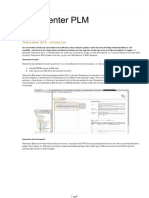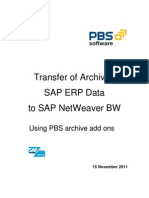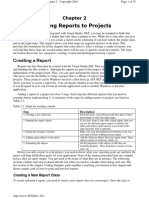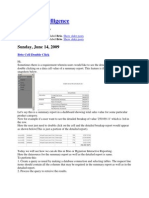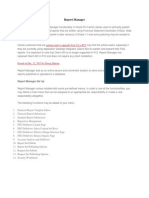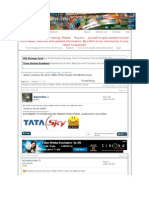0 ratings0% found this document useful (0 votes)
38 viewsAXXX
AXXX
Uploaded by
ChristianAlessiCopyright:
© All Rights Reserved
Available Formats
Download as DOCX, PDF, TXT or read online from Scribd
AXXX
AXXX
Uploaded by
ChristianAlessi0 ratings0% found this document useful (0 votes)
38 views20 pagesCopyright
© © All Rights Reserved
Available Formats
DOCX, PDF, TXT or read online from Scribd
Share this document
Did you find this document useful?
Is this content inappropriate?
Copyright:
© All Rights Reserved
Available Formats
Download as DOCX, PDF, TXT or read online from Scribd
Download as docx, pdf, or txt
0 ratings0% found this document useful (0 votes)
38 views20 pagesAXXX
AXXX
Uploaded by
ChristianAlessiCopyright:
© All Rights Reserved
Available Formats
Download as DOCX, PDF, TXT or read online from Scribd
Download as docx, pdf, or txt
You are on page 1of 20
This document contains text automatically extracted from a PDF or image file.
Formatting may have
been lost and not all text may have been recognized.
To remove this note, right-click and select "Delete table".
Chapter 5: Reports
CHAPTER 5: REPORTS
Development III in Microsoft Dynamics® AX 2009
Scenario
Arnie, the Accounts Receivable clerk, has requested a report that shows the
maximum, minimum and average invoice amounts per customer. Isaac, the
systems developer, has been asked to create this report and to ensure that the
report is printed with a title, date and page numbers on every page.
Architecture
Use reports to print information from the database. The report focuses on the
following:
• Fetching the data
• Filtering the data
• Sorting the data
• Aggregating the data
• Presenting the data in the correct layout
The figure illustrates the structure of the report as displayed in the Application
Object tree (AOT).
5-2
FIGURE 5.1 THE THREE SECTIONS OF A REPORT
The report consists of three main components in the AOT:
• General methods
• Data sources
• Designs
Microsoft Official Training Materials for Microsoft Dynamics ®
Your use of this content is subject to your current services agreement
Methods È Data Sources E Designs
Chapter 5: Reports
Methods
The general or system methods control the execution of the report. These
methods are frequently overridden to supplement or modify the standard
execution of a report. Variables defined in the class declaration of the report can
be accessed from all methods in the report and can be used to hold status and
general information about the report.
Data Sources
Reports are designed to use a query to fetch the data. This section of the report
contains the definition of the query. The structure is similar to the independent
queries in the AOT.
Default filtering ranges and sorting can be specified that the user can override, or
they can be locked to force specific criteria. There is no need to use a
QueryBuildRange object in the code to specify simple filtering, as there is with
forms.
Sorting can be specified as Order By or Group By in the Order mode property on
the data source. Specifying the Group By parameter on the data source enables
aggregating or summing of the fields in the tables. This is a common requirement
in reports. Specifying Sort by will mean that the report is sorted by the fields
specified in the Sorting node.
Design
The design of the report controls the layout and presentation of the data. There
can be many sections to a report design. Some sections are specific to a table, and
will be printed whenever a record in that table is sent. Other sections, for
example, headers and footers, only print in specific sections on the page. There
are also Programmable sections that will only be printed when specifically called
from code.
There can also be multiple designs in a report. This might be used, for example,
when there are different layouts required for an invoice in different companies.
The design to be used can be specified at run time with the reportRun.design()
method. For example in the fetch method you could add the following code:
if (VendParameters::find().UseInvoiceDesign1)
{
this.design(identifierStr(CompanyDesign1));
}
else
{
this.design(identifierStr(CompanyDesign2));
}
Microsoft Official Training Materials for Microsoft Dynamics ®
5-3
Your use of this content is subject to your current services agreement
Development III in Microsoft Dynamics® AX 2009
5-4
Handles to the Objects in a Report
When programming a report you can access the individual objects, for example
the data sources or controls of the report, using the kernel classes used to build
them, or by overriding the methods on the object itself.
All methods in the report are related to an object. This object can be accessed
from the methods associated with it, by using the handle “this”. Note this
reference is relative to where you are programming: for example, if you are
coding in a method attached to a control in the report design, then “this” refers to
the control. If you are coding in a report method, “this” refers to the report.
When referencing an object from a method that is not associated with that object,
you need to use the objects handle. The following table lists the objects and how
you can access them:
Object Access from X++
ReportRun Element
QueryRun queryRun
Query Query
Active record in data source <name of data source in the query>
ReportDesign Name assigned to design, when property
autodeclaration is set to Yes
or
ReportRun.design([<name of design>])
ReportAutoDesignSpecs ReportDesign.autoDesignSpecs()
ReportSectionGroup ReportDesign.SectionGroup
( < tableId >, [ <fieldId> ] )
ReportSection Name assigned to section, when property
autodeclaration is set to Yes
or
Auto design:
ReportAutoDesignSpecs.(<tableId>)
Generated design:
ReportSectionGroup.Section.
(<sectionType>)
Report……Control Name assigned to control, when property
autodeclaration is set to Yes
or
reportSection.control(<fieldId>)
PrinterJobSettings ReportRun.PrintJobSettings()
Microsoft Official Training Materials for Microsoft Dynamics ®
Your use of this content is subject to your current services agreement
Chapter 5: Reports
Data Sources
Report data sources are rarely modified from the code once a report is running.
The user normally requires a lot of flexibility and control over what data is
printed in the report. Reports are therefore created with default values for the data
sources ranges, sorting and grouping.
One data source can be joined to another by dragging the table to be used for the
joined data source to the data source node on the main data source. The join type
can then be specified using the JoinMode property on the joined data source.
Aggregated values can be added by grouping the data source appropriately and
specifying the fields to be aggregated in the Fields node.
Procedure: Using Aggregate Fields
This procedure shows the steps to create a report that lists the average invoice
amount per customer. through the use of aggregated functions.
1. Create a new report in the AOT. Rename the report.
2. Expand the new report node.
3. Expand the Data Sources node.
4. Expand the Query node.
5. Open another AOT window, find the CustInvoiceJour table.
6. Drag the CustInvoiceJour table to the Data Sources node.
7. Expand the new CustInvoiceJour_1 node.
8. Right-click on the Fields node and select properties.
9. Change the Dynamic property to No.
10. Expand the Fields node.
11. Highlight all fields listed under the node and press Delete.
12. Right-click the Fields node and select New > AVG.
13. Right-click on the new field created and select Properties.
14. Change the Field property to Invoice Amount.
15. Under the CustInvoiceJour_1 node, right-click on the Group By node
and select New Field.
16. Right-click on the new field and select Properties.
17. Change the Field property to OrderAccount.
18. Right-click on the Designs node and select New Report Design.
19. Expand the ReportDesign1 node.
20. Right-click on the AutoDesignSpecs node and select Generate Specs
From Query.
Microsoft Official Training Materials for Microsoft Dynamics ®
5-5
Your use of this content is subject to your current services agreement
Development III in Microsoft Dynamics® AX 2009
5-6
21. Right-click on the CustInvoiceJour_Body node and select New
Control > Field From CustInvoiceJour.
22. Drag the InvoiceAmount field from the window that is opened, to the
CustInvoiceJour_Body node.
23. Save and run the report.
Design
A report design can have one of two types of designs: an Auto Design or a
Generated Design. Both report design types can then have multiple sections used
to control how the report is displayed.
Auto and Generated Designs
The Auto Design specifies which fields to include in the report. The actual layout
is decided at runtime after the user has specified the sorting and subtotals. This
approach provides a flexible report where the user can control the break and sum
structure of the report. The disadvantage is that the system developer cannot
control the layout as it is generated at runtime.
Reports with an auto design can use templates that are evaluated at runtime. A
change in the template affects all reports using the template if they are using the
auto design approach.
The generated design specifies which fields to include and the specific layout of
the report. As the break and sum structure is specified by the system developer,
the end-user has less flexibility. The advantage is that the report is presented
exactly as specified and implemented by the system developer.
If both types of design exist, the Generated Design will be used.
Microsoft Official Training Materials for Microsoft Dynamics ®
Your use of this content is subject to your current services agreement
Chapter 5: Reports
List of Design Sections
The following table describes the different sections available in a report design.
Section Description
Prolog Appears at the beginning of a report. Use it to
display items such as a logo, a report title, or the
current date. The prolog is printed before the page
header on the first page of the report.
PageHeader Appears at the top of every page in a report.
Header Only available for generated designs. Appears at
the beginning of a new group of records. Use it to
display items such as a group name.
SectionGroup Only available for generated designs. Appears in
the middle of a report. A section group can contain
a Header, Body, or a Footer section. The structure
of data sources is reflected in the structure of the
section groups.
Footer Only available for generated designs. Appears at
the end of a group of records. Use it to display
items such as sub totals.
PageFooter Appears at the bottom of every page in a report.
Use it to display items such as page numbers.
Epilog Appears at the end of the report. Use it to display
items such as a logo. The epilog is printed just after
the page footer on the last page in a report.
ProgrammableSection Use programmable sections to add any kind of
customized information. To activate a
programmable section, activate it explicitly with an
element.execute(Number) statement. The Number
must be specified in the ControlNumber property
for the design section.
Properties of Report Elements
The Developer Help includes a full list of properties for the Design, Design
Sections and Controls of a report. You can view these lists by opening the
Developer Help, then in the Contents tab expand Microsoft Dynamics AX
SDK > Reference > Object Properties, and then select the appropriate page to
view.
Microsoft Official Training Materials for Microsoft Dynamics ®
5-7
Your use of this content is subject to your current services agreement
Development III in Microsoft Dynamics® AX 2009
Lab 5.1 - Add Header and Footer Sections
Scenario
The report created in Procedure: Using Aggregate Fields needs to have a header
that contains the company name, the date the report was run, the page number,
and a caption. It also requires the company logo to be printed in the bottom right
corner of every page.
Challenge Yourself!
The required header is the standard header used in the report templates. Select a
template for the design that will add this header. Add a footer section and a
bitmap control to display an image file. Set the properties to ensure it displays in
the correct place at a reasonable size.
Step by Step
1. Expand the node in the AOT of the report created in the previous
procedure.
2. Expand the Design node.
3. Right-click on the ReportDesign1 node and select Properties.
4. Change the ReportTemplate property to InternalList.
5. Change the Caption Property to “Average Customer Invoice
Amount”.
6. Expand the ReportDesign1 node.
7. Right-click on the AutoDesignSpecs node and select New > Page
Footer.
8. Right-click on the PageFooter node and select New Control >
Bitmap.
9. Right-click on the Bitmap control and select Properties
10. Set the ImageName property to a file name of an image file to be
displayed as the logo.
11. Set the ResizeBitmap property to Yes
12. Set the Height and Width properties to 3 char and 5 char
respectively. Adjust these values to ensure the image still looks
correct.
13. Set the Left property to Auto (right).
5-8
Microsoft Official Training Materials for Microsoft Dynamics ®
Your use of this content is subject to your current services agreement
Chapter 5: Reports
Methods
One of the key requirements when running reports is for the report to be as
flexible as possible when it comes to allowing the user to select data and display
it as required. When running a simple report that uses the report query, the user
can filter by any field, add related tables to filter based on data in those tables,
sort and group by any field and show or hide sub-totals based on the groupings
created.
Many reports require the developer to control the fetch and display of data a little
more, depending on the complexity of the report. There may also be a
requirement to prompt the user for information that cannot be entered using the
query tool. An example is the customer aging report, where the user is prompted
for information such as the As Of Date, the Aging Buckets to be used, whether to
use the transaction date or the due date on which to base the aging, and many
other criteria. The user can limit the report by customer account, or any other
field on the customer table, but the calculations that are shown are based on the
customer transaction table.
This is done by overriding system methods in the report. For example, to prompt
the user for more information, the dialog() method is overridden, and a dialog
object is created with the necessary fields. To calculate the data, the Fetch
method is overridden and the results from the query retrieved to find which
customers to calculate the amounts for are used.
In this report there are many other methods created that are used for controlling
the layout of the report and displaying the data. You can add display methods
here as with forms, that can be used on fields in the report.
Common Methods to Override
ReportRun.Init
This method initializes the report and its objects. This method is the first event
you can override with the startup of the report.
Never remove the super() call from this method, as this removes the initialization
of all the objects.
To make some manual initialization, it is typically put in this method. This could
include the following tasks:
• Verification of the contents of the args-object received
• Initialization of supporting classes
• Dynamically changes to the design
If manipulation needs access to the objects of the report, wait until the super()
call has been executed.
Microsoft Official Training Materials for Microsoft Dynamics ®
5-9
Your use of this content is subject to your current services agreement
Development III in Microsoft Dynamics® AX 2009
5-10
ReportRun.Dialog
The dialog method is used as with the dialog method in the RunBase class
framework. The method should instantiate an object of type Dialog, add dialog
fields and field groups as required, and return the Dialog object. The values from
the dialog can be retrieved by creating a new method in the report called
GetFromDialog. This is not a system method so is not overridden, but the
ReportRun class checks to see if a method with this name exists and then calls it
if it does.
Note that the dialog method is not called when the report is run directly from the
report node in the AOT. For the dialog method to be called, the report must be
called from a menu point.
ReportRun.Fetch
The fetch method is responsible for the following tasks:
• Initialize the QueryRun
• Prompt for the query
• Prompt for the printer settings
• Fetch the data
• Send the data
The following example in X++ illustrates the standard contents of fetch:
boolean fetch()
{
queryRun = new QueryRun(this);
;
while (queryRun.next())
{
salesTable = queryRun.get(tableNum(salesTable));
this.send(salesTable);
}
return true;
}
If you chose to override fetch, remove the call to super(). Then you are
responsible to re-implement the parts of the example as needed.
Fetch is typically overridden in the following situations:
• The report is not based on a query
• The report contains some processing of the fetched data
• The report is based on a temporary table
Microsoft Official Training Materials for Microsoft Dynamics ®
Your use of this content is subject to your current services agreement
You might also like
- PowerBI Dashboard Training ManualDocument28 pagesPowerBI Dashboard Training ManualNavdeep Tiwari100% (1)
- Crystal Report 8.5 For Visual - 89028Document8 pagesCrystal Report 8.5 For Visual - 89028dsadsadNo ratings yet
- BPC 410 NotesDocument47 pagesBPC 410 NotesGaurav TipnisNo ratings yet
- TC12 SOA - (Blog 2012)Document9 pagesTC12 SOA - (Blog 2012)zikaNo ratings yet
- Transfer of Archived SAP ERP Data To SAP BW by PBS SoftwareDocument28 pagesTransfer of Archived SAP ERP Data To SAP BW by PBS SoftwaretaveesakpNo ratings yet
- E-Commerce RecordDocument61 pagesE-Commerce RecordPrince Khaja100% (1)
- RedBooks-InfoSphere DataStage For Enterprise XML Data Integration PDFDocument404 pagesRedBooks-InfoSphere DataStage For Enterprise XML Data Integration PDFRicardo Zonta Santos100% (1)
- AXXXDocument20 pagesAXXXChristianAlessiNo ratings yet
- MITHUN (Complete Cognos Notes)Document10 pagesMITHUN (Complete Cognos Notes)Shivu KumarNo ratings yet
- Nav2013 Enus Csintro 08Document54 pagesNav2013 Enus Csintro 08AlexNo ratings yet
- PRPC ReportingDocument54 pagesPRPC ReportingsppsruthiNo ratings yet
- Report Studio: Relational and Dimensional Reporting StylesDocument8 pagesReport Studio: Relational and Dimensional Reporting StylesrajuwithualwaysNo ratings yet
- Cognos Interview Questions and AnswerDocument5 pagesCognos Interview Questions and Answerabdul87sNo ratings yet
- AX2012 User Interfaces 03Document24 pagesAX2012 User Interfaces 03indusaNo ratings yet
- Report Builder Guide To Creating ReportsDocument51 pagesReport Builder Guide To Creating ReportsNima SajadiNo ratings yet
- Self Service Interface For Business Users: 7.1 Explore The IBM Cognos Business Insight Advanced InterfaceDocument4 pagesSelf Service Interface For Business Users: 7.1 Explore The IBM Cognos Business Insight Advanced InterfaceHarry KonnectNo ratings yet
- Creating A Report Using The Report WizardDocument9 pagesCreating A Report Using The Report WizardSwapnil YeoleNo ratings yet
- Visual Basic ReportsDocument16 pagesVisual Basic ReportsCharlemagne Tan DalidaNo ratings yet
- Basics of MicroStrategy Reporting and Project DesignDocument72 pagesBasics of MicroStrategy Reporting and Project Designyuva_sriNo ratings yet
- Calculated Key Figures and Restricted Key FiguresDocument20 pagesCalculated Key Figures and Restricted Key FiguresVamsi Kiran100% (1)
- Reporting Options For LabVIEW DataDocument4 pagesReporting Options For LabVIEW DatawilliamIINo ratings yet
- Best Practices Report Studio GeneralDocument16 pagesBest Practices Report Studio Generalsubhabratapati_238No ratings yet
- CrystalReports Capitulo02 AdicionarReporteDocument32 pagesCrystalReports Capitulo02 AdicionarReporteJuan Carlos CifuentesNo ratings yet
- SSRS 2012 MaterialDocument58 pagesSSRS 2012 MaterialSubrahmanyam SudiNo ratings yet
- Brio IrDocument11 pagesBrio IrSuresh BabuNo ratings yet
- Report Microsoft Dynamics AXDocument56 pagesReport Microsoft Dynamics AXmagive249No ratings yet
- Dataset Dataset Datatable DatatableDocument1 pageDataset Dataset Datatable DatatableNiña Chris BuenNo ratings yet
- Report Definition Rule FormDocument5 pagesReport Definition Rule FormHarish Babu YemineniNo ratings yet
- DataMigration AX2012Document29 pagesDataMigration AX2012koggenNo ratings yet
- HFM FAQsDocument14 pagesHFM FAQsSyed Layeeq Pasha100% (1)
- Ax2012 Enus Devi 02Document32 pagesAx2012 Enus Devi 02sergio_741No ratings yet
- Bring Structure Into Your Data With Autocad Plant Report CreatorDocument10 pagesBring Structure Into Your Data With Autocad Plant Report CreatorahmedalishNo ratings yet
- CrystalReports Capitulo03 ModeloDeObjetosDocument8 pagesCrystalReports Capitulo03 ModeloDeObjetosJuan Carlos CifuentesNo ratings yet
- Business Intelligence Simplified: An Overview: 5.1 Information Delivery Leading PracticesDocument7 pagesBusiness Intelligence Simplified: An Overview: 5.1 Information Delivery Leading PracticesHarry KonnectNo ratings yet
- 7.5 Search For Meaningful Information: MeasuresDocument7 pages7.5 Search For Meaningful Information: MeasuresHarry KonnectNo ratings yet
- SQL Server Reporting Services (SSRS)Document52 pagesSQL Server Reporting Services (SSRS)ChillagattaAdarshNo ratings yet
- Chap24 Reports Final PDFDocument8 pagesChap24 Reports Final PDFJaalala BiyyaaNo ratings yet
- PS-project Information System.Document82 pagesPS-project Information System.SUNIL palNo ratings yet
- Prithis Das - Oracle Report Manager Tips Tricks TrapsDocument36 pagesPrithis Das - Oracle Report Manager Tips Tricks TrapsMoises NavarroNo ratings yet
- Extending The Power BI Template For Project For The WebDocument7 pagesExtending The Power BI Template For Project For The WebMahmoud Karam100% (1)
- Birst Trial - Getting Started Exercise 3 DashboardDocument11 pagesBirst Trial - Getting Started Exercise 3 DashboardAvinNo ratings yet
- CHAPTER 2: Tutorial: Lesson I: Create A Tabular ReportDocument18 pagesCHAPTER 2: Tutorial: Lesson I: Create A Tabular ReportNadien MargaretaNo ratings yet
- Report Manager and FSG Setup and GuidDocument15 pagesReport Manager and FSG Setup and GuidzahidrafibhattiNo ratings yet
- Ax2012 Enus Deviv 12 PDFDocument60 pagesAx2012 Enus Deviv 12 PDFBachtiar Yanuari100% (1)
- Finally, A Tool For Business Users! A Step-By-Step Practical Approach To Pharma Sales Reporting Using SAS® Enterprise Guide® 4.3Document18 pagesFinally, A Tool For Business Users! A Step-By-Step Practical Approach To Pharma Sales Reporting Using SAS® Enterprise Guide® 4.3av0224atgmailcomNo ratings yet
- Manage Journal Line Rules in Fusion Receipt Accounting PDFDocument8 pagesManage Journal Line Rules in Fusion Receipt Accounting PDFBayo JekayinfaNo ratings yet
- BPC 420 NotesDocument94 pagesBPC 420 NotesGaurav Tipnis100% (1)
- f461fcd5 2f9a 4313 A938 Ed22ecb7a7e2Crystal Report BCS IIIDocument16 pagesf461fcd5 2f9a 4313 A938 Ed22ecb7a7e2Crystal Report BCS IIIpriya jainNo ratings yet
- Searches and Ad-Hoc ReportingDocument10 pagesSearches and Ad-Hoc ReportingVivek ViswambharanNo ratings yet
- AET Cookbook v1 3Document14 pagesAET Cookbook v1 3Twesigomwe Gilbert GabrielNo ratings yet
- C8-06-Intro To Query StudioDocument11 pagesC8-06-Intro To Query StudioSteve PhanNo ratings yet
- Dynamics AX 2009 Development PresentationDocument83 pagesDynamics AX 2009 Development PresentationghisuddinNo ratings yet
- Microsoft Dynamics GP 2013 Reporting, Second EditionFrom EverandMicrosoft Dynamics GP 2013 Reporting, Second EditionRating: 5 out of 5 stars5/5 (2)
- How To Develop A Performance Reporting Tool with MS Excel and MS SharePointFrom EverandHow To Develop A Performance Reporting Tool with MS Excel and MS SharePointNo ratings yet
- The Data Detective's Toolkit: Cutting-Edge Techniques and SAS Macros to Clean, Prepare, and Manage DataFrom EverandThe Data Detective's Toolkit: Cutting-Edge Techniques and SAS Macros to Clean, Prepare, and Manage DataNo ratings yet
- PROC REPORT by Example: Techniques for Building Professional Reports Using SAS: Techniques for Building Professional Reports Using SASFrom EverandPROC REPORT by Example: Techniques for Building Professional Reports Using SAS: Techniques for Building Professional Reports Using SASNo ratings yet
- Biznet Cloud Computing - Workshop 2010Document1 pageBiznet Cloud Computing - Workshop 2010Muhamad FirmansyahNo ratings yet
- Chapter 7Document21 pagesChapter 7Abdisamed AllaaleNo ratings yet
- (Network Security 2017-Jan Vol. 2017 Iss. 1) Wood, Michael - How To Make SD-WAN Secure (2017) (10.1016 - S1353-4858 (17) 30006-5) - Libgen - LiDocument3 pages(Network Security 2017-Jan Vol. 2017 Iss. 1) Wood, Michael - How To Make SD-WAN Secure (2017) (10.1016 - S1353-4858 (17) 30006-5) - Libgen - LiElias DendirNo ratings yet
- IP Addressing: Format of An IP AddressDocument8 pagesIP Addressing: Format of An IP AddressLovemore ManyerukeNo ratings yet
- Saint Leo University Introduction To Security Information COM-416 July 26, 2014Document7 pagesSaint Leo University Introduction To Security Information COM-416 July 26, 2014SaravananNo ratings yet
- Shashank SrivastavaDocument2 pagesShashank Srivastavashashank srivastavaNo ratings yet
- Resume Anitha PDFDocument2 pagesResume Anitha PDFSasi sivakumarNo ratings yet
- RDBMS PrivilegesDocument7 pagesRDBMS PrivilegesSumeet ChikkmatNo ratings yet
- Lab 1Document4 pagesLab 125Namrata MhatreNo ratings yet
- Cara Setting Scanner Kyocera FS-1135MFPDocument2 pagesCara Setting Scanner Kyocera FS-1135MFPNoe PranataNo ratings yet
- T-Mobile Data Breach AssignmentDocument6 pagesT-Mobile Data Breach Assignmentrachana singhNo ratings yet
- Project 1 Part 2 ReportDocument9 pagesProject 1 Part 2 Reportapi-498226155No ratings yet
- Exercise 1: Bank Account Management SystemDocument4 pagesExercise 1: Bank Account Management Systemtarek gritliNo ratings yet
- Guide Use Any Sim Card BSNL MTNDocument6 pagesGuide Use Any Sim Card BSNL MTNKijanjooNo ratings yet
- National University of Modern Languages - NUML: (Department of Computer Science)Document56 pagesNational University of Modern Languages - NUML: (Department of Computer Science)Mohsin AliNo ratings yet
- HW Resources Cisco NexusDocument8 pagesHW Resources Cisco Nexusakm_nhNo ratings yet
- IT Infrastructure Management AnswersDocument17 pagesIT Infrastructure Management AnswersNIKHIL ARORA100% (1)
- Grammarly Software SRS DefineDocument4 pagesGrammarly Software SRS DefineMr AlphaNo ratings yet
- Bogdan TancauDocument2 pagesBogdan TancauSureshNo ratings yet
- 21 1 GTPP Reference - Chapter - 01Document38 pages21 1 GTPP Reference - Chapter - 01AlNo ratings yet
- Asst. Prof. Nayna N Mistry (M.C.A, Net, Gset) Sutex Bank College of Computer Applications and Sciencepage 1Document22 pagesAsst. Prof. Nayna N Mistry (M.C.A, Net, Gset) Sutex Bank College of Computer Applications and Sciencepage 1Krushit NadodaNo ratings yet
- Week3 Recap OOPDocument56 pagesWeek3 Recap OOPYu WonNo ratings yet
- 1.7 System CallsDocument13 pages1.7 System CallsrevicseNo ratings yet
- ICT English NotesDocument49 pagesICT English NotesAnkita DasNo ratings yet
- 278848601-IBantay GordonCollege RevisedDocument6 pages278848601-IBantay GordonCollege RevisedAlfred Aguilar LegaspiNo ratings yet
- CarryMap Observer Functionality Android enDocument22 pagesCarryMap Observer Functionality Android enFred FreddyNo ratings yet
- Cloud Computing Interoperability: Introduction, Concerns and ChallengesDocument5 pagesCloud Computing Interoperability: Introduction, Concerns and ChallengesYash SharmaNo ratings yet



